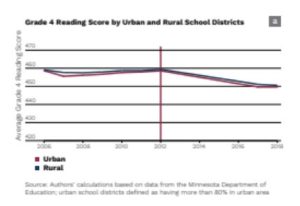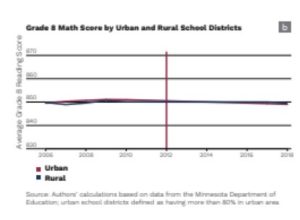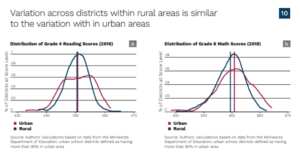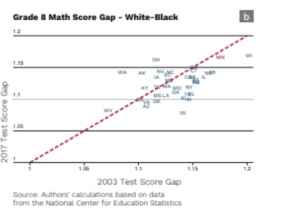A new report from the Federal Reserve Bank of Minneapolis provides new analytical tools that show Minnesota has some of the largest gaps in the nation on outcome measures by race and socio economic status. View the Report: Statewide Crisis: Minnesota’ Achievement Gaps.
As part of the report, the Federal Reserve, published a powerful interactive map of all Minnesota school districts. It includes over 100 variables on student, adult, economic, academic characteristics to allow users to see how that district and others score, and where the district ranks among all Minnesota districts.
Key Patterns
The report identifies these key patterns:
- On average, Minnesota performs well compared with all other states on standardized test scores, graduation rates, and college readiness. However, it has some of the largest gaps in the nation on these measures by race and socioeconomic status.
- Racial and income gaps in standardized test scores and college readiness have increased over time, while gaps in graduation rates have decreased.
- Even as graduation rates overall have increased in recent years, college readiness indicators have declined. This demonstrates that Minnesota is graduating an increasing proportion of students who are unprepared for college.
- On average, there is no gap between urban and rural school districts on standardized test scores and graduation rates in recent years. However, there is a large variation in achievement gaps across schools within rural districts and across schools within urban districts.
- These gaps are not only racial; low-income white students significantly trail higher-income white students across Minnesota.
- Variation in outcome gaps across schools also exist within the charter school system and across schools within traditional public school districts.
- Minnesota has successfully reduced variation in education inputs, such as per capita expenditures across districts and class sizes across schools. However, achievement gaps across race and socioeconomic status have persisted for decades. (Statewide Crisis, pp. 3-4)
The report supports these key patterns with maps, graphs and tables with multiple data sources.
Rural-Urban Comparisons
The Federal Reserve analysis found no urban-rural average test score gap in Minnesota since 2006.


The Federal Reserve analyzed reading and math achievement scores between urban and rural school districts from 2006-2018.
To create this analysis, the Federal Reserve defined school districts “as urban if 80 percent of its population lives in urban census tracts.” (ibid., p. 5) This granular approach resulted in 13 Greater Minnesota school districts being classified as ‘urban.’
The Federal Reserve concludes that variation in scores across school districts is due to factors other than urban or rural, as illustrated by a series of line graphs showing distributions of scores among rural and urban districts. The distributions are statistically the same. (pp. 14-15)

Learning from Other States
The report compares Minnesota’s record in closing the achievement gaps from 2003 to 2017 with how the other 49 states did over the same time period.
 The dotted 45 degree line represents no change in the relative gap. States below the line reduced their gap in 8th grade White to Black achievement. The full report has similar charts for reading and for White-Hispanic gaps.
The dotted 45 degree line represents no change in the relative gap. States below the line reduced their gap in 8th grade White to Black achievement. The full report has similar charts for reading and for White-Hispanic gaps.
The authors acknowledge “that throughout the country, many states struggle with persistent education achievement gaps based on race, ethnicity, and socioeconomic status…. At the same time, the data indicate some states have shown signs of closing these gaps, even though no state has fully closed them.”
After reviewing some states and districts with some success in closing education gaps, the authors conclude “that there is hope…. that closing achievement gaps is challenging, but possible.”
Common themes across the success stories include:
- Giving schools greater autonomy to lead by implementing locally relevant programs and attracting, developing, and retaining high-quality teachers.
- Focusing on school quality, such as using data and teacher coaching to improve instruction.
- Supporting students and families through individualized services.
Resources
………………………………………………………





